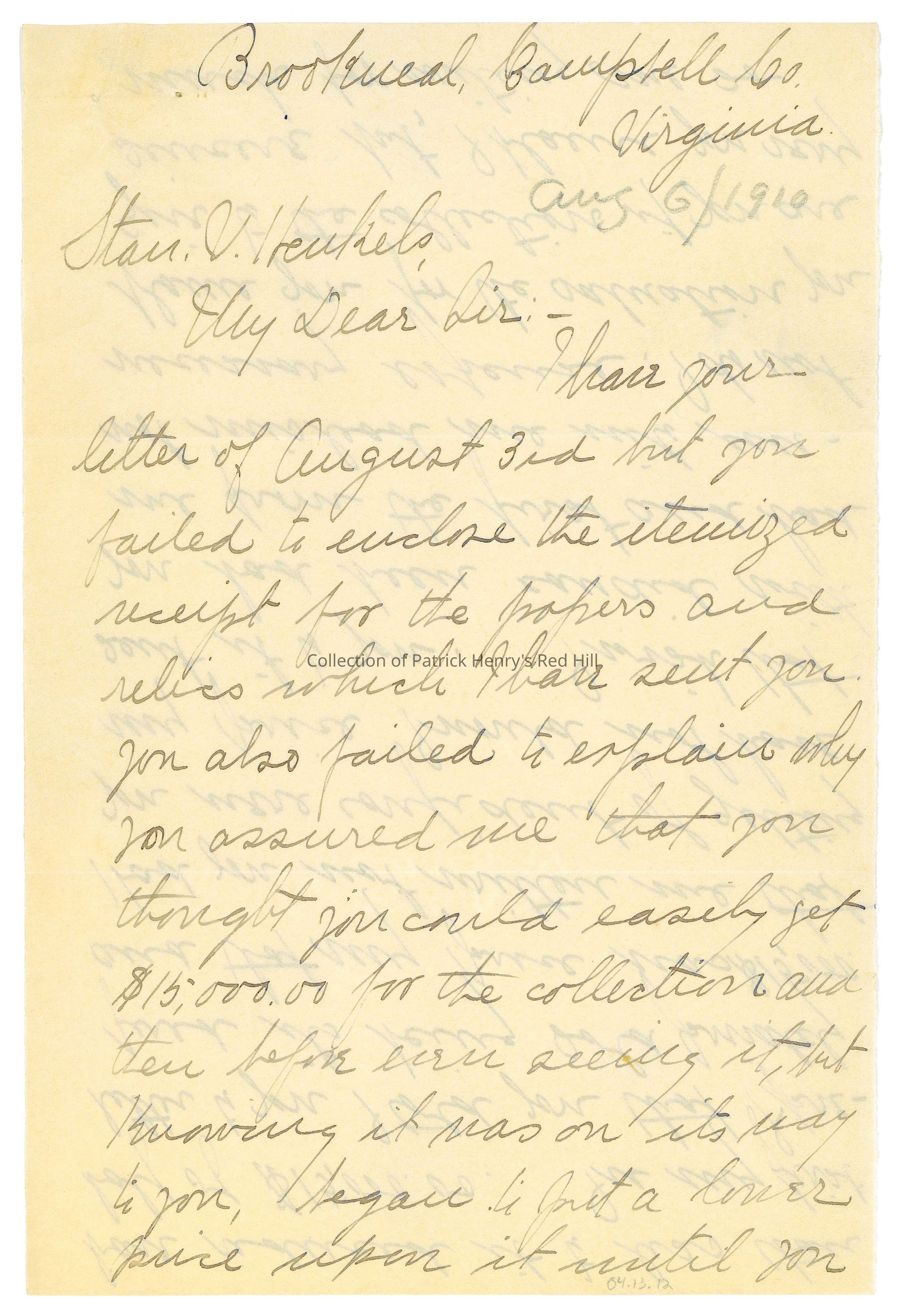Notes
This letter belongs to a collection of correspondence primarily from Lucy Gray Henry Harrison (1857–1944) to Stanislaus “Stan” Vincent Henkels (1854–1926) concerning a proposed sale of Patrick Henry family heirlooms in 1910. Mrs. Harrison was Patrick Henry's great-granddaughter and the last Henry descendant to own and live at Red Hill. She grew up in Richmond, Virginia, and moved to Duluth, Minnesota, after marrying real estate millionaire Matthew Bland Harrison (1853–1892) in 1886. In 1905, she inherited Red Hill and moved onto the property, where she lived along with her sister, Elizabeth Watkins Henry Lyons (1855–1920), and her assistant, Elizabeth H. Kerper (1890–1964).
Mrs. Harrison inherited many of the family heirlooms that had belonged to Patrick Henry and many of his papers. In 1910, on the advice of Philadelphia neurologist and writer Dr. Weir Mitchell (1829–1914), she contacted Stan V. Henkels about a possible private sale or public auction of some of these pieces. Mr. Henkels was an antique dealer in Philadelphia well-known for his auctions and private sales to collectors. In 1890 and 1891, he cataloged two sales of George Washington-related documents and artifacts while he worked as chief auctioneer for the company Thomas Birch’s Sons. The correspondence from Mrs. Harrison to Mr. Henkels details their business negotiations from May 1910 leading up to the sale of the items in Philadelphia on December 20, 1910. It also includes letters concerning a settling of accounts between them up through February 1911.
The Henry heirlooms Mrs. Harrison sent to auction included a collection of Henry’s letters and other documents. Among these were several letters between Henry and Virginia politician Richard Henry Lee (1732–1794) about various issues and events during the Revolution. Lee’s letter to Henry of April 20, 1776, advocates for a Declaration of Independence from Great Britain two and a half months before the signing of that document. This letter was sold at the auction for $40.
Thomas Sully’s (1783–1872) portrait of Patrick Henry is an oil painting on canvas commissioned in 1815 by Henry’s first biographer, William Wirt (1772–1834). An engraving of the portrait was featured on the frontispiece of Wirt’s 1817 biography, “Sketches of the Life & Character of Patrick Henry.” Sully based the portrait on one of the few images of Henry painted from life: a miniature created, not by a French artist in 1791, as Mrs. Harrison believed, but in 1795 by Sully’s half-brother, Lawrence Sully (1769–1804). Thomas Sully’s portrait of Henry was given by Wirt to Henry’s youngest son, John (1796–1868), who passed the portrait on to his son William Wirt Henry (1831–1900), who loaned it to the Virginia State Library in Richmond from 1873 to 1884 before he passed it on to his daughter, Lucy Harrison. In 1902, Mrs. Harrison loaned the portrait again to the Virginia State Library but reclaimed it in 1910 to sell it at Mr. Henkels’ auction, where it was purchased by Charles Hamilton (1847–1930) for $4,000. The Colonial Williamsburg Foundation later purchased the portrait from the Hamilton family and currently has it in its collection. Mr. Henkels’ doubt about the Sully portrait’s authenticity may be related to an unfounded claim published in 1909 in “The Pennsylvania Magazine of History and Biography” that the Lawrence Sully miniature, which served as Thomas Sully’s inspiration, was not painted from life. The magazine’s editor, Charles Henry Hart (1847–1918), invalidated this claim before the December 1910 auction when he identified the miniature as a life portrait.
Lawrence Sully’s miniature of Henry was painted from life in 1795. The miniature passed through the family of Patrick Henry’s older half-brother, John Syme Jr. (1727–?), and in 1910, was owned by Syme’s great-grandson, John Syme Fleming Jr. (1842–1922). Mr. Fleming sent it to auction at the same 1910 sale that Mrs. Harrison sent her Henry heirlooms to. It was sold at auction for $660 to Gilbert Sunderland Parker (1861–1921), the curator of paintings at the Pennsylvania Academy of the Fine Arts. At some point, it passed into the possession of Herbert Lee Pratt (1871–1945), who left it to Amherst College in 1945.
Mrs. Harrison’s secretary was Elizabeth H. Kerper, a Pennsylvania native who lived with Mrs. Harrison at Red Hill for three decades.
The Patrick Henry Memorial Foundation purchased this letter from an online seller in May 2004 as part of the collection of correspondence.
